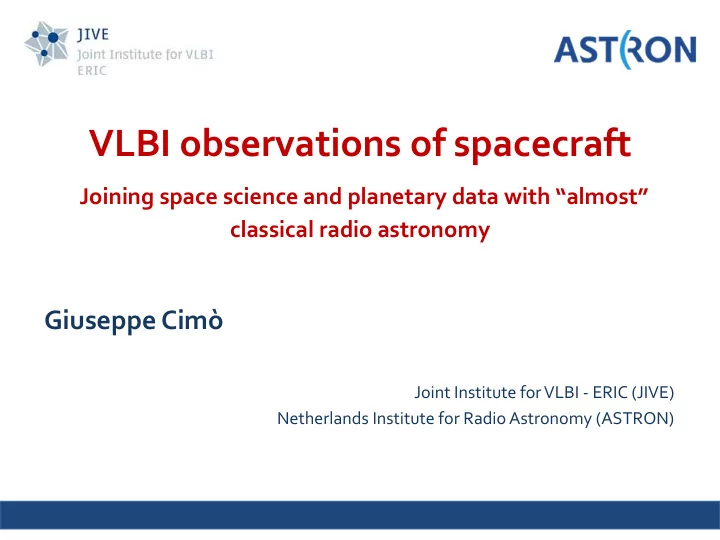

VLBI observations of spacecraft Joining space science and planetary data with “almost” classical radio astronomy Giuseppe Cimò Joint Institute for VLBI - ERIC (JIVE) Netherlands Institute for Radio Astronomy (ASTRON)
PRIDE: Space science and Radio Astronomy Near-field VLBI: “almost” classical radio astronomy Planetary Radio Interferometry and Doppler Experiments (PRIDE) A multi-purpose, multi disciplinary enhancement of mission science return, based on Doppler tracking and phase-referencing VLBI technology and science ASTERICS European Data Provider Forum 15 June 2016 2 Heidelberg
Why VLBI observations of Spacecraft ? Credits: NASA/ESA Planetary Radio Interferometry and Doppler Experiment (PRIDE) is able to provide highly accurate estimates of the state vectors for the orbiters and landers by means of Very Long Baseline Interferometry. By determining spacecraft state vectors we are given A windy day on Titan! the ability to study a wide variety of phenomena: Wind on other planets or moons • Internal structure and composition • Atmosphere dynamics ESA’s VEX drag • Improve ephemeris of moons JUICE! • Interplanetary Scintillation • General relativity experiments • ASTERICS European Data Provider Forum 15 June 2016 3 Heidelberg
Our data products Several levels of data • Raw data: the actual data recorded at each telescope Huge amount Mostly noise! Credits: ESA • Cross-correlation: VLBI data after correlation What astronomers get still uncalibrated • Frequency: radio signal emitted by onboard communication system • Processed data – Images are made from the VLBI data Real position of spacecraft in the sky – Doppler Shifts after correcting for a number of effects Spacecraft velocity • Scientific data products – ephemerides – gravity field measurements – space weather – orbit determination – … ASTERICS European Data Provider Forum 15 June 2016 4 Heidelberg
MEX Phobos flyby 28 – 29 December 2013 Closest flyby of MEX ~50km More than 30 radio telescopes globally ~26 hours of continuous observation time Credits: ESA (for Mars, Phobos and MEX) 3 consecutive Mars revolutions (7 hours long) Duev et al A&A 2016 Doppler detection noise, 10 s integration: • mean value 2.5 mHz • median value 2.2 mHz • mod (maximum log-normal fit) value 1.7 mHz 30 μm /s ASTERICS European Data Provider Forum 15 June 2016 5 Heidelberg
Spacecraft astrometry Duev et al A&A 2016 Displacements between measured and predicted MEX celestial position, 2 min per point Credits: ESA Median 3σ formal error for the full range are: RA 34 μas → 35 m Dec 58 μas → 60 m ASTERICS European Data Provider Forum ASTERICS European Data Provider Forum 15 June 2016 15 June 2016 6 6 Heidelberg Heidelberg
Our data Raw data for the Phobos flyby 100+ TeraBytes • Data are recorded in hard disks and shipped to JIVE for the cross-correlation • After correlation, the disks are recycled: no archive for raw data www.jive.eu • Miscommunication with other communities: ESA requires archiving of raw data Cross-correlation • JIVE archive of FITS files • Proprietary time for PIs Doppler shift • ASCII table with times and frequencies • Complementary to Radio Science agreement on formats agreement on repositories agreement on data policies Processed data • Images and maps created with AIPS (on my hard drive!) VO • Table with lateral positions: formats depend on experiment • Complementary to onboard experiments agreement on formats, repositories, policies,… Scientific data products • Collaborations with space agencies • Collaboration with other groups (planetary and space science) ASTERICS European Data Provider Forum 15 June 2016 7 Heidelberg
Space weather Molera Calvés et al. 2014 Observations of ESA’s spacecraft at different solar elongation from 2009 to 2016 • Interplanetary scintillation • Solar wind studies • Analysis of Coronal Mass Ejection • Scintillation effects on communication signal • Spacecraft observations and experiment strategies Two-way phase scintillation for ESA’s Venus Express. Data • VLBI phase referencing cycle show the phase scintillation index measured with VLBI radio determination telescopes. Strict communication with ESOC for transmission windows Ad hoc observing arrangement with the radio telescopes PI driven experiments ASTERICS European Data Provider Forum 15 June 2016 8 Heidelberg
Our data Raw data from VLBI disk packs • Data are recorded in hard disks and shipped to JIVE for the cross-correlation • Single dish only: No cross-correlation • After correlation, the disks are recycled: no archive for raw data Doppler shift • ASCII table with times and frequencies • Local archiving at JIVE Processed data • Binary files with measured frequencies and frequency shifts • Phase variations due to scintillation • Complementary to space weather experiments agreement on formats, repositories, policies,… Scientific data product • Phase scintillation index • turbulence parameters in the interplanetary medium • parametrization of solar wind, ionosphere and troposphere • Collaborations with space agencies • ESA Space Situational Awareness • Compatibility with ESA Space Weather network ASTERICS European Data Provider Forum ASTERICS European Data Provider Forum 15 June 2016 15 June 2016 9 9 Heidelberg Heidelberg
Conclusions and feedback PRIDE has proven to be beneficial for a wide range of scientific applications. PRIDE is an experiment of ESA’s JUICE mission Challenges: Help from VO experience – Different formats • Automatic format generation/conversion? – Different repositories – Different policies JUICE • Proprietary windows Credits: ESA • Archiving – Different communities and backgrounds • Space agencies • PIs of onboard experiments • Planetary and space scientists Feedback and suggestions: – Interactions with EUROPLANET-VESPA – VLBI and VO? EVN FITSfinder and Italian model (Cristina’s talk) – Interdisciplinary events ASTERICS! (of course!) ASTERICS European Data Provider Forum 15 June 2016 10 Heidelberg
Recommend
More recommend